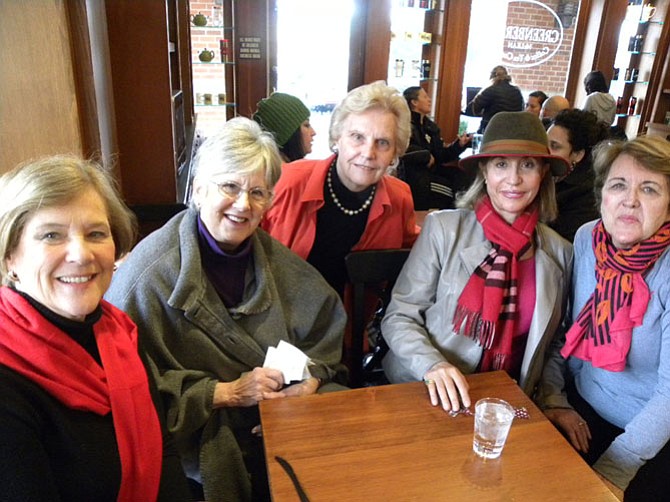Everyday an informal group of McLean residents go to “the office,” Greenberry’s Coffee & Tea Company. From left, Mary Ludden, Susan Christie, Carole L. Herrick, Cristina Granja of McLean and KK Piper of Vienna. Photos by Abigail Constantino/The Connection
”There’s old McLean and there’s new McLean,” said Carole L. Herrick, author of “Legendary Locals of McLean” which went on sale on Jan. 19. Old McLean are property owners who once owned expansive farms or dairies, while new McLean are people who settled in the area when the Central Intelligence Agency came in 1961. For a while old and new McLeans coexisted, new Cadillacs would be parked next to beat up old Chevy trucks used in the farms.
Now, “Old McLean has pretty much disappeared,” said Herrick. The farms and pastures where dairy cows once grazed have given way to subdivisions and new housing. “That’s progress …t hat’s life,” said Herrick. Her new book contains images of McLean residents annotated with explanations of historical significance from as early as the War of 1812 to the present.
The community branched from the McLean rail station near Old Dominion Drive and Chain Bridge Road. It is now occupied by a restaurant, a bank, and other businesses. John Roll McLean, who owned The Washington Post, along with West Virginia senator Stephen Benton Elkins, built the Great Falls and Old Dominion Railroad in 1904 and named stations after themselves. Herrick believes that John Roll McLean has probably never set foot in the place that bears his name.
SINCE ITS FOUNDING, many prominent and well-known residents have called McLean home. One example from Herrick’s book is Justice Robert Jackson, who served as Associate Justice of the U.S. Supreme Court from 1941-1954 and was one of the justices during the Brown v. Board of Education case. Jackson was also the U.S. chief counsel for the prosecution during the Nuremberg Trials in 1945-1946, taking a leave of absence from the Supreme Court.
There was also Mary Stalcup Markward, who for years was ostracized by her McLean neighbors for being a member of the Communist Party but was, in fact, an informant for the Federal Bureau of Investigation and testified before the House Committee on Un-American Activities in 1951.
Herrick’s new book also features African-Americans who lived in what was known as Lincolnsville, now Chesterbrook. Descendants of Christopher Columbus Hall, who in 1865 bought 26 acres of land for farming and divided it among his 11 children, continued to live on Cottonwood Street. One of them was Martina Hall, the first person to survive an operation replacing the aortic valve with a plastic one in 1952. She was known as the Tick Tock Woman because her heart can be heard beating from a distance.
Herrick’s book illustrates how deeply intertwined McLean is with Washington, D.C., as many government figures were attracted to its proximity to the capital. But it is the commitment of its residents to “spirited volunteerism” that has created its identity. “McLean is a community of volunteers … it’s what makes the community a community,” said Herrick. Because the city is not incorporated, many McLean events — such as the Reindog Parade and WinterFest — survived because of volunteers, she said.
“LEGENDARY LOCALS of McLean” is published by Arcadia Publishing. Herrick is the vice president of the Historical Society of McLean and chairman of the Fairfax County History Commission. She was a nationally ranked tennis player and was inducted in the ITA Women’s Collegiate Hall of Fame. She lives in McLean.

